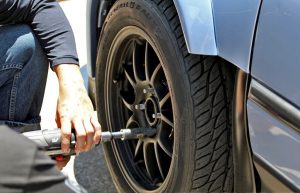
So you’ve just spent 120 hours with your son or daughter teaching them how to operate a vehicle and navigate traffic safely.
They are now technically eligible to sit for their provisional test and if successful will be allowed to drive unaccompanied on Australia roads.
While this is a great thing for everyone to experience it is astounding to learn many Australian drivers do not know or understand many fundamental elements of the vehicles that they are operating and more importantly what to do in the instance something goes wrong.
At Leasecorp we help finance new and used vehicles for many young Australia’s, so we have put together what we feel is the 15 most important things everyone should know about cars once they get a driving licence.
1. How to change a tyre:
Inevitably due to the nature of tyres and the harshness of many Australian roads all of us will at some point experience a flat tyre. What many people don’t seem to realise is how easy they are to change. The NRMA website gives an excellent step by step instruction on how to change a flat tyre safely and with ease.

2. Check tyre pressure:
This one is an important one, driving with over- or under-inflated tires is a dangerous and an unnecessary hazard. This is due to the uneven distribution of weight transferred to each wheel while driving. In the instance of heavy breaking, your vehicle is at higher risk or losing control.
Most service stations have automatic pressure gauge systems that let you quickly check and adjust your tyres.
Every car should have a chart inside the driver-side door that lists the optimum pressure for the front and rear tires. Achieving correct levels is an easy way to maximise fuel economy too.
3. How to change oil:
To ensure the longevity and performance of your engine, oil levels should be monitored frequently.
Many people leave this to mechanics at a scheduled services, but this is a costly mistake. The Supercheap Auto website gives you a great guild on how to both check and replace your engine oil.
4. Understand how different cars handle:
As a new driver you will most likely have only been driving one vehicle, but as you become more experienced you will eventually drive other friends and family members cars. It is very important to understand how different cars drive and handle to ensure safe operation.
There are typically three different types of drives, front wheel, rear wheel, or all wheel. Front-wheel drive vehicles in low-traction conditions can cause you to plough ahead, even though you have the wheel fully turned. Rear-wheel-drive is popular for high-performance cars but can cause you to lose the tail end of the vehicle if driven dangerously. All-wheel drive and four-wheel drive are the safest for tricky conditions and will send power to the wheels with the most traction.
5. How to drive a manual vehicle:
It is amazing to learn the high number of Gen Y and Z’s that cannot operate a manual vehicle. Although many car manufacturers are increasing production of automatic cars there are still a large number of manual cars on our roads. whether it’s just to avoid being the annoying friend that can’t share the road trip or for emergency situations, it pays to know how to drive a manual car.
6. How to keep a maintenance log:
Unless you have purchased a new vehicle and intend to have it serviced by the manufacturer at regular intervals, it pays to carry and fill out a maintenance log of all work that has been done on your car. This not only saves you being ripped off by mechanics but also improves the value of your vehicle come the resale time as the purchaser can see that you have been meticulous in the servicing and preservation of the car.
7. What to keep in your glove box:
This one is just to make life easier. As a must, you should always carry a copy of your insurance information, registration and drivers licence. And in the case of an emergency, a flashlight and first-aid kit are must-have items for your glove box. And for the overly prepared, hand sanitiser, gloves, tissues and bottle of water (not plastic).
8. How to Parallel park:
Have you ever been stuck behind a driver making numerous attempts at a parallel park? Annoying isn’t it. It’s not just that people are impatient, it’s that there is a mathematical process to parallel parking and it’s easy. Once mastered anyone can park quickly and easily. Check out this.
9. How to safely control slide:
Ok, so we don’t get a lot of snow in Australia, but we do get slippery, icy and greasy road conditions that if not driving suitably can lead to loss of traction or sliding.
To counter the sliding and regain control of the car, 1. don’t panic or overcorrect 2. lift off the brake pedal (do not stomp on the break even with ABS) to allow the wheels to freely rotate, turn into the slide, and then press down to slow the rotating rubber mass. Repeat this process until you come to a stop.
10. How to get unstuck when bogged:
This will be generally only encountered if four-wheel-driving but an important one to know. Check out this 4×4 recovery at https://www.campertraileraustralia.com.au/features/technical/1503/4wd-recovery-how-to-unbog-your-vehicle.
11. To warm up your engine at stationary or by driving:
According to studies carried out at the Argonne National Laboratory when your engine is cold, the gasoline is less likely to evaporate and create the correct ratio of air and vaporised fuel for combustion. Engines with electronic fuel injection have sensors that compensate for the cold by pumping more gasoline into the mixture. The engine continues to run rich in this way until it heats up to about 40 degrees Fahrenheit.
“That’s a problem because you’re actually putting extra fuel into the combustion chamber to make it burn and some of it can get onto the cylinder walls,” Stephen Ciatti, a mechanical engineer who specialises in combustion engines at the Argonne National Laboratory in Chicago, told Business Insider. “Gasoline is an outstanding solvent, and it can actually wash the oil off the walls if you run it in those cold idle conditions for an extended period of time.”
The life of components like piston rings and cylinder liners can be significantly reduced by gasoline washing away the lubricating oil, not to mention the extra fuel that is used while the engine runs rich. Driving your car is the fastest way to warm the engine up to 40 degrees so it switches back to a normal fuel to air ratio. Even though warm air generated by the radiator will flow into the cabin after a few minutes, idling does surprisingly little to warm the actual engine. The best thing to do is start the car, take a minute to knock the ice off your windows, and get going.
12. How to check fluid levels:
Again to ensure you get the most optimum level of performance and prolong the lifespan of your car it is essential that you know, check and replace all the key fluids in your engine. The five main ones are listed at Popular Mechanics.
13. How to change a headlight:
Not only is it illegal, driving with a headlight out makes negotiating traffic and roads more difficult for both the driver, other drivers and pedestrians. Generally speaking, car headlights are easy to replace, but let’s face it, manufacturers could make it a bit simpler. What is difficult is that most vehicles have different types of globes for the high and low beam as well as different ways of changing. If you’re a first timer check out – http://www.dmv.org/how-to-guides/headlight.php.
14. How to jump start a car battery:
First things first, to do this, always keep a pair of jumper cables in your boot –you never know when they will come in handy. Turn off both cars. Start with the dead battery. Put a red clamp on the positive (+) terminal of the dead battery. Attach the other red clamp to the positive terminal of the live battery, and the black clamp to the negative (–) terminal of the live battery. Then attach the final black clamp to an unpainted metal surface on the dead car’s engine block (prevents hazardous sparking). Turn on the live car, and then try to jump-start the dead car. Run the dead car for at least half an hour to charge the battery back up. Wa-lah your back in business.
15. What fuel you should be running your car on:
This one is a tough one as most engines car, in theory, operate on any grades of fuel, assuming you’re not putting diesel in a petrol car and vice versa. The NRMA website has an excellent overview of fuel types. It pays to understand what grade of petrol to put in your car to achieve the greatest performance and range.
If you’re in the market for a new or used car, let us get you approved today, call us on 1800 232 615.
Get Approval Today!
